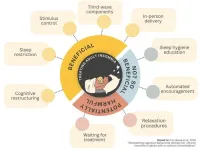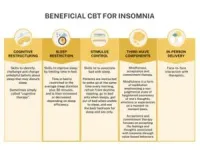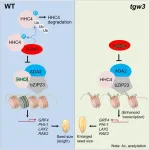A combination of cognitive and behavioral strategies, ideally delivered in person by a therapist, maximizes the benefits of cognitive behavioral therapy for insomnia (CBT-I), according to new research. CBT-I is a form of talk therapy, which can be delivered in person or through self-help guides. By analyzing 241 studies, involving over 30,000 adults, researchers identified the most beneficial components of CBT-I. These included: cognitive restructuring, third-wave components, sleep restriction, stimulus control and in-person delivery. Self-help with human encouragement could also be beneficial, while waiting for active treatment and enforcing relaxation procedures appeared to be potentially harmful. Understanding which components of CBT-I can offer the most benefit will hopefully help practitioners help their patients get a better night’s sleep.
It’s time for bed but your mind is racing. Maybe you get up several times a night or wake up early in the morning feeling hardly rested at all. It’s estimated that up to a third of adults experience insomnia at some point, and anywhere from 4% to 22% chronically. Chronic insomnia can impact daily life, making it difficult to function when awake or causing distress. More serious cases may require support and treatment, and one medication-free option is cognitive behavioral therapy for insomnia.
CBT-I is a form of therapy that uses educational, cognitive or behavioral strategies to help patients improve their quality of sleep. It may be delivered in person or online, through an app or a guidebook, with the support of a therapist or independently. Previous studies have shown that CBT-I can be a beneficial and low-risk option for patients with chronic insomnia. However, as it encompasses a broad range of strategies which can be delivered in different ways, it has been difficult to determine which are most successful and if all are necessary for a patient to experience an improvement.
A team led by researchers at the University of Tokyo Hospital analyzed 241 studies of chronic insomnia from 1980-2023, to try and connect the different threads of CBT-I with their outcomes. The studies included 31,452 adult participants, mainly from North America and Europe, with an average age of 45.4 years. “We expected to find some behavioral components (such as sleep restriction and stimulus control) beneficial, but it was surprising to find that some cognitive components (such as cognitive restructuring and third-wave components) were also effective,” explained Yuki Furukawa, lead author and a medical doctor at the university hospital.
Using a statistical method called component network meta-analysis, the team ranked the effects of different interventions. According to their results, although following a self-help guide with encouragement from other people was helpful, in-person interaction with a therapist was more beneficial. Other critical components included: cognitive restructuring (skills to identify, challenge and change unhelpful beliefs about sleep), sleep restriction (limiting time in bed), stimulus control (re-associating bed with sleep) and third-wave components (mindfulness, acceptance and commitment therapy).
On the other hand, sleep hygiene education (explaining the biology of sleep and providing recommendations about lifestyle and environment) did not appear to be essential. Trying to follow relaxation procedures (such as structured physical or cognitive exercises) could be counterproductive, while knowingly having to wait for treatment to begin appeared to have a harmful effect.
“Overall, our findings identified several essential components of CBT-I which can lead to an intervention that maximizes treatment efficacy, minimizes treatment burden and increases scalability, that is, makes it easier to offer this treatment to more patients. Further large-scale trials are needed to confirm these contributions,” said Furukawa. “We hope that our research encourages practitioners who are interested in CBT-I to learn streamlined CBT-I, so that in turn more people who experience insomnia can be offered this relatively simple, noninvasive yet potentially powerful psychotherapy.”
######
Paper Title:
Yuki Furukawa, Masatsugu Sakata, Ryuichiro Yamamoto, Shun Nakajima, Shino Kikuchi, Mari Inoue, Masami Ito, Hiroku Noma, Hikari Nishimura Takashina, Satoshi Funada, Edoardo G. Ostinelli, Toshi A. Furukawa, Orestis Efthimiou, Michael Perlis. Components and delivery formats of cognitive-behavioral therapy for chronic insomnia in adults with or without comorbidities: a systematic review and component network meta-analysis. JAMA Psychiatry. Doi: 10.1001/jamapsychiatry.2023.5060
Funding
This research was supported in part by a grant-in-aid from the Japan Agency for Medical Research and Development (AMED) (grant number JP22de0107005) to TAF, and a JSPS Grant-in-Aid for Scientific Research (grant number 21K03049) to MS.
Declaration of interests
YF has received consultancy fee from Panasonic outside the submitted work.
MS reports personal fees from SONY outside the submitted work.
SF received a research grant from the Pfizer Health Research Foundation outside this project. EGO has received research and consultancy fees from Angelini Pharma.
TAF reports personal fees from Boehringer-Ingelheim, DT Axis, Kyoto University Original,
Shionogi and SONY, and a grant from Shionogi, outside the submitted work; In addition, TAF has patents 2020-548587 and 2022-082495 pending, and intellectual properties for Kokoro-app licensed to Mitsubishi-Tanabe. MP wrote treatment manuals and books for CBT-I, teaches CBT-I, and is a founder of Hypknowledge LLC.
RY, SN, SK, MIN, MIT, HN, HNT, OE report no competing interest.
Useful Links
The University of Tokyo Hospital: https://www.h.u-tokyo.ac.jp/english/
Research Contact:
Yuki Furukawa, M.D.
Department of Neuropsychiatry,
The University of Tokyo Hospital,
Hongo 7-3-1, Bunkyo-ku, Tokyo 113-8655
Email: furukaway-psy@h.u-tokyo.ac.jp
Press contact:
Mrs. Nicola Burghall
Public Relations Group, The University of Tokyo,
7-3-1 Hongo, Bunkyo-ku, Tokyo 113-8654, Japan
press-releases.adm@gs.mail.u-tokyo.ac.jp
About the University of Tokyo
The University of Tokyo is Japan's leading university and one of the world's top research universities. The vast research output of some 6,000 researchers is published in the world's top journals across the arts and sciences. Our vibrant student body of around 15,000 undergraduate and 15,000 graduate students includes over 4,000 international students. Find out more at www.u-tokyo.ac.jp/en/ or follow us on X (formerly Twitter) at @UTokyo_News_en.
END





